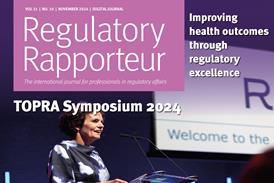All Regulatory Rapporteur articles in September 2022
View all stories from this issue.
-

-

-
 Editorial
EditorialRegulatory operations: Evolution and revolution
‘Operations’ does not quite do justice to the critical role that these individuals play in the global team
-
 Focus
FocusThe changing role of regulatory operations
The regulatory profession has always attracted diverse individuals with a wide range of professional experiences. Top talent has migrated from preclinical labs, clinical operations, quality, and a range of functions to pursue a career in regulatory operations. The role of the regulatory operations professional has and continues to evolve as the requirements for the position have changed drastically. These professionals have witnessed a substantial change in the responsibilities associated with their role. These changes are directly related to those in global submission requirements and associated standards, emerging technologies, and shift ing resourcing models, among other factors.
-
 Focus
FocusHow data remediation and stewardship is becoming a standard responsibility for regulatory operations professionals
Data quality is becoming increasingly critical to the success of medicinal product applications and has the potential to increase the speed and efficiency of medicines supply to patients. There is an industry move towards a data-driven regulatory enterprise, highlighted particularly through the arrival of initiatives such as identification of medicinal products (IDMP), real world evidence (RWE), digital application dataset integration (DADI), electronic product information (ePI), marketing status (IRIS), US FDA knowledge-aided assessment and structured application (KASA) and eCTD 4.0, among others.
-
 Journal
JournalHarmonising regulation of medicinal allergen products throughout the European Union – the historic situation and subsequent CMDh guidance
Allergen products in the EU are defined as goods ‘intended to identify or induce a specific acquired alteration in the immunological response to an allergizing agent’. Historically, allergens were authorised under the national frameworks of member states (MS) with some legislation pre-dating the Treaty of Rome in 1957. This led to regulatory problems, such as pharmacovigilance monitoring standards. The Co-ordination Group for Mutual Recognition and Decentralised Procedures – Human (CMDh) addressed these authorisation issues and published a document on recommendations to common regulatory approaches for medicinal allergen products. This article provides an overview of the CMDh guidance, including a summary of some of the responses received during its consultation phase.
-
 Journal
JournalEU reclassification (Rx to OTC switch) regulatory framework – what are the key challenges for industry and how might these be overcome? Part 2
Rx to over the counter (OTC) switch is the regulatory process that medicines must go through before they can be purchased in a pharmacy or general shop without a prescription. This research investigates the challenges the pharmaceutical industry has faced with this process in the European Union and proposes where improvements could be made. It is important for consumers to have direct access to medicines without a prescription as this allows time for doctors to focus on more urgent care needs. This emphasis on consumer ‘self-care’ is even more important now, during a pandemic, when face-to-face consultations with doctors have reduced.
-
 Journal
JournalInclusion of older people in drug development and clinical trials: Part 1
As the global population ages, older people will increasingly become the main users of medication. Much work has already been done by regulatory authorities to review legislation, leading to the 2013 publication of the EMA’s Geriatric Medicines Strategy. It reported, however, that many clinical trials still did not include a representative number of older people – aged 65 and over – despite the drugs in development were most likely to be used by this cohort. This two-article series will analyse if the publication of ICH E7 Q&A influenced the number of older people included in clinical trials. Furthermore, a qualitative questionnaire assessed the extent to which clinical trials are designed to adequately represent older people. In part one, I will focus on the legislative framework governing drug development for older patients, and the sub-classifications of age groups.



















